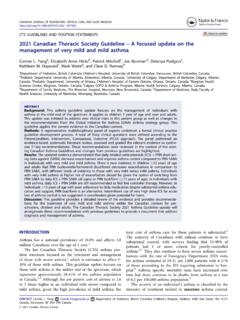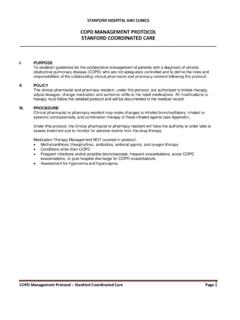Transcription of Canadian Thoracic Society Clinical Practice Guideline on ...
1 Full Terms & Conditions of access and use can be found Journal of Respiratory, Critical Care, and SleepMedicineRevue canadienne des soins respiratoires et critiques et de la m decinedu sommeilISSN: 2474-5332 (Print) 2474-5340 (Online) Journal homepage: Thoracic Society Clinical PracticeGuideline on pharmacotherapy in patients withCOPD 2019 update of evidenceJean Bourbeau, Mohit Bhutani, Paul Hernandez, Shawn D. Aaron, MeyerBalter, Marie-France Beauchesne, Anthony D Urzo, Roger Goldstein, AlanKaplan, Fran ois Maltais, Don D. Sin & Darcy D. MarciniukTo cite this article: Jean Bourbeau, Mohit Bhutani, Paul Hernandez, Shawn D. Aaron, MeyerBalter, Marie-France Beauchesne, Anthony D Urzo, Roger Goldstein, Alan Kaplan, Fran oisMaltais, Don D. Sin & Darcy D. Marciniuk (2019): Canadian Thoracic Society Clinical PracticeGuideline on pharmacotherapy in patients with copd 2019 update of evidence, CanadianJournal of Respiratory, Critical Care, and Sleep Medicine, DOI: link to this article: online: 18 Oct your article to this journal View related articles View Crossmark dataCTS GUIDELINES AND POSITION PAPERSC anadian Thoracic Society Clinical Practice Guideline on pharmacotherapy inpatients with copd 2019 update of evidenceJean Bourbeaua , Mohit Bhutanib , Paul Hernandezc , Shawn D.
2 Aarond, Meyer Baltere, Marie-FranceBeauchesnef, Anthony D Urzog, Roger Goldsteinh, Alan Kaplani, Franc ois Maltaisj, Don D. Sink, andDarcy D. Marciniukl aResearch Institute of the McGill University Health Centre, McGill University, Montr eal, Quebec, Canada;bDepartment of Medicine, Universityof Alberta, Edmonton, Alberta, Canada;cDepartment of Medicine, Dalhousie University, Halifax, Nova Scotia, Canada;dThe Ottawa Hospital,Ottawa Hospital Research Institute, University of Ottawa, Ottawa, Ontario, Canada;eMount Sinai Hospital, University of Toronto, Toronto,Ontario, Canada;fDepartment of Pharmacy, Universit e de Montr eal, Montr eal, Quebec, Canada;gPrimary Care Lung Clinic, University ofToronto, Toronto, Ontario, Canada;hWest Park Healthcare Centre, University of Toronto, Toronto, Ontario, Canada;iFamily Physician AirwaysGroup of Canada, Richmond Hill, Ontario, Canada;jInstitut Universitaire de Cardiologie et de Pneumologie de Qu ebec, Universit e Laval,Qu ebec, Quebec, Canada.
3 KDepartment of Medicine, University of British Columbia, Vancouver, British Columbia, Canada;lRespiratoryResearch Centre, University of Saskatchewan, Saskatoon, Saskatchewan, CanadaABSTRACTIn this Guideline update, we highlight important and new findings related to pharmacologicaltherapy of chronic obstructive pulmonary disease ( copd ) that should change Clinical Practice andimprove disease management . We present updated evidence, recommendations and expert clin-ical remarks on maintenance pharmacotherapy in patients with stable copd . The diagnosis andnonpharmacological therapy of copd are out-of-scope for this patients with copd who have persistent shortness of breath, exercise intolerance and/or poorhealth status despite using inhaled LAMA or LABA monotherapy, we recommend augmentingtreatment to LAMA/LABA dual therapy. In patients with high-risk exacerbations, LAMA/LABA is thepreferred choice to ICS/LABA except in patients with previous exacerbations who have higher per-ipheral eosinophilia.
4 There is no role for ICS monotherapy; when indicated, ICS should only beused in combination with bronchodilators. Treatment step up in copd is proposed as a practicalconstruct supported by evidence that inhaled combined therapy is superior to monotherapy andtriple therapy to dual therapy in certain patient populations. Because the superiority of inhaled tri-ple or dual bronchodilator therapy may not be achieved in every patient, step down may beconsidered for some patients (not at high risk for future exacerbations), but should be done withclose medical supervision, as the risk of Clinical deterioration is real and continues to exist. Thedecision of changing a therapy should always occur after a complete evaluation of the patientand the potential benefit to a change in therapy; as well as an assessment of any adverse effectsof the therapy, and with a review of patient adherence, inhaler technique and patient therapy plays a foundational role in therapy, but it should never be the soletreatment in managing copd patients.
5 Clinicians should always combine and optimize pharmaco-logical and nonpharmacological therapies with the dual goals of reducing symptoms and prevent-ing acute exacerbations of copd (AECOPD).R ESUM ELa pr esente mise a jour des lignes directrices met de l avant de nouveaux r esultats importants sur letraitement pharmacologique de la maladie pulmonaire obstructive chronique (MPOC) qui devraientmodifier la pratique clinique et am esentons unemise a jour des donn ees probantes et des recommandations, et des observations cliniques d expertssur la pharmacoth erapie d entretien pour les patients dont la MPOC est stable . La pr esente mise les patients ayant une MPOC et dont l essoufflement, l intol erance al effort et lad et erioration de l etat de sant e persistent malgr e une monoth erapie d antimuscarinique a longuedur ee d action (AMLA) ou de b^eta2-agoniste a longue dur ee d action (BALA), nous recommandonsune progression du traitement vers une bith erapie AMLA/BALA.
6 Chez les patients pr esentant unrisque elev ed exacerbations, il faut privil egier une bith erapie AMLA/BALA plut^ot qu une associ-ation de corticost ero de en inhalation (CSI)/BALA, sauf chez les patients ayant d ej a subi des exac-erbations et dont le nombre d eosinophiles de sang p eriph erique est elev e. Il n y a pas lieu derecourir a la monoth erapie de CSI; lorsqu ils sont indiqu es, les CSI doivent^etre utilis es uniquementKEYWORDSC hronic obstructivepulmonary disease ; copd ; Guideline ; pharmacotherapy ; Canadian ThoracicSociety; CTSCONTACTJean Epidemiology and Clinical Research Unit, Research Institute of the McGill University HealthCentre, 5252 de Maisonneuve West, office , Montreal, QC H4A 3S5, versions of one or more of the figures in the article can be found online Executive Committee Members: Jean Bourbeau, Mohit Bhutani, Paul Hernandez, Darcy Marciniuk.
7 2019 Canadian Thoracic SocietyCANADIAN JOURNAL OF RESPIRATORY, CRITICAL CARE, AND SLEEP association avec des bronchodilatateurs. Pour la mise en place du traitement dans les cas deMPOC, il est propos ed adopter une approche pratique et fond ee sur les donn ees probantes selonlaquelle une inhaloth erapie combin ee est sup erieure a la monoth erapie et une trith erapie estsup erieure a une bith erapie chez certaines populations de patients. Etant donn e que la sup eriorit ede la trith erapie ou de la bith erapie al aide d un bronchodilatateur pourrait ne pas^etre observ eechez tous les patients, il faudra envisager une d egression de traitement pour certains patients (quine pr esentent pas de risque elev ed exacerbations futures), mais sous une etroite supervisionm edicale, car le risque de d et erioration clinique est r eel et persiste. La d ecision de modifier untraitement doit toujours^etre prise apr es une evaluation compl ete du patient et des avantagespossibles d une modification du traitement; ainsi qu une evaluation de tous les effets ind esirablesdu traitement et une v erification de l observance du patient, de sa technique d inhalation et deses pr ef pharmacoth erapie joue un r^ole fondamental, mais elle ne doit jamais^etre utilis ee comme seultraitement pour la prise en charge des patients ayant une MPOC.
8 Les cliniciens doivent toujoursassocier et optimizer les traitements pharmacologiques et non pharmacologiques en ayant le dou-ble objectif de soulager les sympt^omes et de pr evenir les exacerbations aigu es de laMPOC (EAMPOC).IntroductionSince the last published Canadian Thoracic Society (CTS)position statement on the pharmacotherapy in patients withchronic obstructive pulmonary disease ( copd ) in 2017,1several important publications have necessitated an updateto the current approach. This document is intended to guidebest Practice in light of recent Clinical Practice , an integrated, comprehensiveapproach to care should include: a diagnosis of copd confirmed with spirometry; Clinical evaluation of the patient; and comprehensive management , which includes non-pharmacological and pharmacological interventions(Figure 1).Thediagnosis of copd should be considered in patientsat risk of developing this disease .
9 Patients smoking historyshould be the main focus as it remains the most importantrisk factor. However, clinicians should be aware of anincreased risk of copd in individuals reporting a past med-ical history of asthma and/or severe childhood respiratorydisease. Additionally, patients who have been exposed topassive smoke and/or to indoor biomass fuel are also atincreased risk for the development of includesindividuals from developing countries where indoor biomassexposure is the leading cause of copd . Physicians shouldalso be attentive to patients presenting with exacerbation-like respiratory events in the office or emergency setting,which may be an initial presentation of previously undiag-nosed copd . These events are common in undiagnosedCOPD (22% in undiagnosed compared to 40% in diagnosedCOPD) and have substantial impact on health service util-ization, such as emergency department (ED) visits and hos-pital exacerbation-like respiratory event canbe a trigger (opportunity)
10 For patients to come to the atten-tion of the healthcare system and for clinicians to considerthe diagnosis of copd and/or to optimize dis-ease robust population data have confirmed thatmany individuals with copd remain undiagnosed, butsymptomatic, with an increased risk of exacerbations, pneu-monia and , undiagnosed copd , butasymptomatic, can also have exacerbations and patients who are asymptomatic may have adaptedtheir lives to the limitations associated with their diseaseand may not want to reflect upon changes that occur tothem as being a problem, that is, denial. If the physicianuses probing questions, then symptoms may be betterdetermined. This reality calls into question the validity ofcurrent recommendations for diagnosis of copd that sug-gest targeted testing with spirometry only for is important to remind physicians that spirometryisessential for the diagnosis of copd , that is, a fixed post-bronchodilator ratio of the FEV1/FVC of< or<thelower limit of normal (LLN) ratio ( , less than the lowerfifth percentile of the reference value from a healthy popula-tion).




